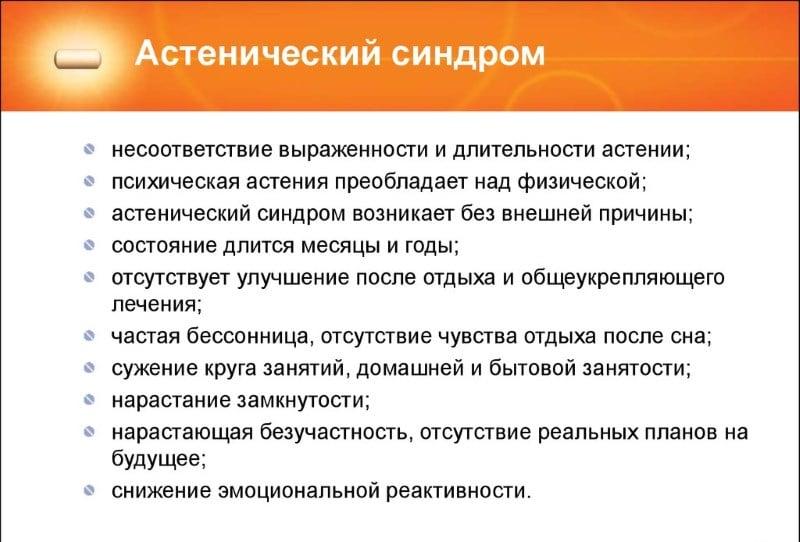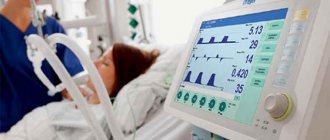Main symptoms:
- Depression
- Closedness
- Migraine
- Impaired concentration
- Disorders of the gastrointestinal tract
- Sleep disturbance
- Sensory impairment
- Fainting
- Fever
- Increased fatigue
- Loss of consciousness
- Irritability
- Absent-mindedness
- Deterioration of short-term memory
- Cardiopalmus
Astheno-vegetative syndrome is a functional disorder of the autonomic nervous system, which regulates the normal activity of all internal organs and systems of the body. The disease is based on a disturbance in the passage of impulses from nerve endings to tissue cells, or disturbances are observed between neurons of the central nervous system and peripheral systems with the obligatory participation of the autonomic trunk.
Online consultation on the disease “Astheno-vegetative syndrome”.
Ask a question to the specialists for free: Neurologist.
- Etiology
- Symptoms
- Diagnostics
- Treatment
- Possible complications
- Prevention
Disturbances in signal transmission can be delayed or premature; in fact, the signal is interrupted and then returned. Depending on the degree of development of pathological processes, the manifestation of deviations in organs or tissues will be observed. The disease is diagnosed after consultation with a therapist, neurologist, or psychiatrist. The prognosis for the treatment of this type of disease is positive. Astheno-vegetative syndrome occurs in children and adults.
Main reasons for development
The development of asthenic disorders is most often facilitated by exhaustion of the body after protracted infectious diseases, stress, and psychological shocks. In the modern rhythm of life, astheno-vegetative syndrome occurs very often, due to the enormous load that the human body experiences.
- heavy physical activity;
- mental stress;
- chronic stress;
- severe psychological shocks;
- chronic lack of sleep;
- frequent flights, changes in climate and time zones;
- lack of a clear work schedule;
- unfavorable psychological atmosphere in the family and at work, etc.
In some cases, the trigger point in the development of astheno-vegetative syndrome is somatic, neurological, endocrinological, cardiovascular or infectious diseases. Asthenic disorder often accompanies rehabilitation after traumatic brain injury; its manifestations may also be associated with circulatory disorders in the brain, degenerative processes in this organ and damage to its blood vessels.
Etiology of the disease
This disease makes itself felt in adolescence; during this period, hormonal changes in the body lead to its depletion or are accompanied by the presence and progression of pathologies that could have arisen in the initial period of development:
- Physical or psychological trauma that was accompanied by constant stress or emotional overload;
- Disturbances in the functioning of the endocrine system, as a consequence of a previous infectious disease;
- Weakening of the liver and kidneys, decreased immunity due to long-term use of antibiotics;
Indirect reasons for the occurrence of the syndrome can be an unbalanced diet:
- Due to abnormal intake of vitamins or minerals into the body, which normalize the rapid development of organs;
- Metabolic disorder, which manifests itself in the inability to digest healthy foods;
- Abuse of food that helps deteriorate the intestinal microflora and the functioning of the digestive tract: sweet carbonated drinks, fast food.
At an early age, the cause for the onset and progression of the syndrome can be the manifestation of disturbances in biorhythms, heavy mental work and lack of physical activity - physical inactivity.
Asthenovegetative syndrome can develop for reasons similar to any disorder of the autonomic nervous system. This set of reasons may include a long course of infectious diseases, malnutrition, hypoxia, various unfavorable environmental factors, such as stress factors, a difficult situation in the family or conditions outside it. It is worth noting that the disease manifests itself with approximately the same frequency regardless of the patient’s gender and age.
Often, in such cases, the clinical manifestations of the syndrome may indicate the early stages of complex psychopathological conditions.
It is worth noting that modern living conditions have made this disease somewhat “younger”. In recent years, cases of manifestations of the first symptoms of the syndrome in children of middle and primary school age have been increasingly recorded. As a rule, such manifestations disappear after a long rest and a change of environment, however, with longer exposure to risk factors, the disease completely adapts and progresses.
The most common causes of ABC are:
- Excessive brain activity, which is especially common in school-age children who spend too much time on schoolwork and homework.
- Long-term infectious diseases.
- Traumatic brain injuries.
- Psychological stress of moderate to severe severity.
- Physical working conditions are too difficult.
- Chronic lack of sleep. This reason is most often seen among women.
- Sudden and frequent changes in work rhythm - changes in schedules, lack of vacation, and so on.
- Changing time zones with a difference of several hours. In this case, asthenovegetative syndrome often occurs in combination with culture shock.
- Other causes that affect the central nervous system by altering homeostasis.
Astheno-vegetative syndrome
Astheno-vegetative syndrome is a functional disorder of the autonomic nervous system, which regulates the normal activity of all internal organs and systems of the body.
The disease is based on a disturbance in the passage of impulses from nerve endings to tissue cells, or disturbances are observed between neurons of the central nervous system and peripheral systems with the obligatory participation of the autonomic trunk.
Online consultation on the disease “Astheno-vegetative syndrome”.
Ask a question to the specialists for free: Neurologist.
Disturbances in signal transmission can be delayed or premature; in fact, the signal is interrupted and then returned.
Depending on the degree of development of pathological processes, the manifestation of deviations in organs or tissues will be observed. The disease is diagnosed after consultation with a therapist, neurologist, or psychiatrist.
The prognosis for the treatment of this type of disease is positive. Astheno-vegetative syndrome occurs in children and adults.
Astheno-vegetative syndrome can develop under the influence of long-term infectious diseases, due to poor nutrition, when the body does not receive the necessary vitamins and minerals, as a result of oxygen starvation of the brain, if the room is not ventilated and the fresh air is not walked. Stress and a difficult microclimate in the family also have an impact if parents are alcoholic or have a drug addiction.
This disease occurs in all age categories, regardless of gender, but is found more often in women, due to an unstable psyche.
The appearance of the first symptoms of astheno-vegetative syndrome in children of middle and primary school age is often recorded. At this age, the signs of pathology quickly disappear if you change the environment, but with prolonged exposure to external factors or infections, the disease can develop into a chronic course with progression.
The following are the causes of ABC:
- school overload, when the child studies a lot without rest;
- long-term infectious diseases;
- brain injuries;
- constant stress;
- physical overload;
- insomnia;
- disruption of the endocrine system.
Separately, it is necessary to highlight a chronic disease - sphenoiditis, which leads to this type of autonomic disorders.
This is due to the fact that the sphenoid sinus, in which pus accumulates (with this disease), closely borders the structures of the central nervous system.
When a large amount of infection accumulates in the sinuses, the mucous membrane is destroyed, and toxins penetrate the nervous tissue at the base of the brain, causing all sorts of neurological processes:
- sleep is disturbed;
- appetite decreases;
- memory deteriorates;
- frequent dizziness;
- general weakness;
- irritability.
All pathological processes that can affect the brain and central nervous system are dangerous and require immediate treatment.
The main causes of astheno-vegetative syndrome
- Studies have shown that a fairly large number of serious pathological processes begin with astheno-vegetative syndrome.
- This type of pathology is characterized by a stepwise clinical manifestation.
- The symptoms are as follows:
- attention decreases;
- short-term memory deteriorates;
- fatigue increases;
- sleep deteriorates;
- heart rate increases with minimal exertion;
- disturbances in the gastrointestinal tract;
- migraines are present;
- frequent loss of consciousness;
- the underlying disease appears (in the absence of therapy).
Fainting or migraines may often occur. Adolescents may develop depression, absent-mindedness, isolation, and attention problems.
With sphenoiditis, there is an increase in temperature, deterioration of tactile sensitivity, and irritability. At the first signs of neurological abnormalities, you should seek advice from a specialist. You cannot eliminate the symptoms on your own.
Astheno-vegetative syndrome is observed in isolation or in combination with deeper mental or physiological disorders.
The patient consults with a therapist, neurologist, or psychiatrist, after which a preliminary diagnosis is made and he is referred for additional studies:
- blood analysis;
- An X-ray of the sinuses is taken;
- Ultrasound of blood vessels and head is prescribed.
Ultrasound of leg vessels
Once the diagnosis is confirmed, appropriate therapy is prescribed, however, it will differ in adults and children.
For neurological disorders in a child, strong drugs are very rarely prescribed, and in the absence of congenital pathologies, non-drug treatment is prescribed.
A special diet with the correct diet is prescribed, fruits and vegetables, and foods rich in potassium are introduced. Additionally, herbal preparations may be prescribed to minimize possible harm to the body.
Massages, relaxing baths, herbal decoctions are practiced, and light exercises are prescribed. Drugs to improve blood circulation and vitamin complexes are prescribed.
If complications and inflammatory processes are observed, then antimicrobial therapy is prescribed. If the condition is severe and the patient is over 15 years old, they may prescribe antipsychotics, antidepressants, and painkillers.
If neurological problems are not identified in time, the pathological process will worsen, which can lead to the following complications:
- neurological diseases;
- sphenoiditis;
- psychoneurological disorders.
To prevent such serious complications, it is necessary to start treatment in a timely manner and follow the doctor’s recommendations.
As a preventive measure, you should lead a healthy lifestyle, eat well and properly, avoid stress, avoid severe physical and mental overload, and walk in the fresh air more often.
Symptoms of asthenoneurosis
Typically, patients do not attach much importance to the first signs of the syndrome, as they attribute them to fatigue. People turn to a doctor for help when it becomes impossible to cope with accumulated problems on their own. Most often, the diagnosis is made if there are no somatic or neurological disorders.
The first symptoms of asthenic syndrome include:
- Apathy and causeless irritability;
- Regular fatigue;
- Decreased immunity, which leads to the occurrence of infectious and colds.
In children, severe asthenoneurosis manifests itself differently than in adults. The child is observed:
- Sudden mood changes;
- Lack of appetite and complete refusal to eat;
- Uncontrollable attacks of aggression;
- Frequent crying and moodiness;
- Taking out anger on toys and favorite things;
- Continuous fatigue;
- Regular pain in different areas of the head;
- Decreased academic performance at school;
- Difficulty communicating with other children.
Treatment of the syndrome in children
Treatment of asthenic syndrome in children is slightly different from treatment of the disease in adults. To help your child you should:
- Introduce into his diet as much as possible the right healthy food, useful with vitamins and various microelements;
- Eliminate drinks that contain caffeine from your diet;
- Ventilate the baby’s room several times a day;
- In the evening you need to spend time in the fresh air, it is especially useful to walk just before bed;
- Ensure full, healthy sleep both during the day and at night;
- Avoid watching TV and playing on the computer during an exacerbation of the disease.
How to get rid of the problem?
In the first stages, the doctor recommends non-drug adjustments: daily routine, diet, moderate physical and mental stress, as well as sleep patterns.
The need to exclude stimulating and irritating foods, for example, those containing caffeine, spicy and salty foods, fast food, etc. Indications for the use of soothing teas, relaxing baths, and relaxation massage courses.
If the disease is protracted, symptomatic therapy is prescribed: therapeutic manual therapy, mineral baths, electropheresis, halochamber, drugs to improve brain activity, vascular agents.
Any intervention using drug therapy must be carried out by a qualified specialist.
Asthenovegetative syndrome with severe manifestations requires medical intervention. When depressive conditions develop, antidepressants and sedatives are used.
To correct and treat the disease - neuroleptics, nootropic, neurometabolite drugs, neuroleptic stimulants can be used. In order to prevent self-medication of severe forms, you should consult a general practitioner and a neurologist.
How does the disease manifest?
The main signs of astheno-vegetative syndrome are similar to other diseases and disorders, so if you have the symptoms listed below, you should first consult your doctor. Prescribing treatment on your own can only aggravate the situation and harm your health.
Cubital tunnel syndrome
Vegetovascular dystonia of this type can be identified by a number of symptoms. The patient has:
- frequent headache;
- dizziness, sometimes fainting;
- constant fatigue, lack of sleep, weakness;
- digestive problems;
- increased sweating;
- frequent nausea and vomiting;
- cardiopalmus.
In addition, unpleasant phenomena such as insomnia, depression, and depression may occur. Signs appear especially often in adolescents, whose adolescence most strongly affects their mood. The patient is also diagnosed with a slow reaction, problems with perception and memory, and shortness of breath.
Symptoms cannot be ignored and a doctor’s consultation is necessary - in addition to astheno-vegetative syndrome in adults, these signs may indicate other dangerous problems. It is necessary to begin treatment immediately, because the disorder is life-threatening, especially at an advanced stage.
One of the manifestations of the disease is a rapid heartbeat.
The clinical picture varies among patients. It depends on the characteristics of a person’s character, temperament, activity, and external stimuli. Only a doctor will be able to identify this pathology and carry out differential diagnosis.
Diagnostics

Diagnosis of the disease, first of all, involves an oral interview with the patient. The doctor must find out everything that worries the patient. Usually the clinical picture of the disease becomes clear in its first stages. That is why it is not difficult to start treating asthenic syndrome as early as possible. The main thing is to determine the real cause of the disease, since it is its elimination that guarantees successful treatment and complete recovery of the patient.
Asthenoneurosis can be confused with fatigue, which occurs with increased mental or physical stress. According to the ICD, 10 patients are diagnosed with code F48.0, which stands for other neurotic disorders.
Treatment
At the first suspicion, you should contact a therapist, after which the doctor makes an opinion and, if necessary, refers the patient to specialists in the appropriate profiles. If there are no significant disorders, non-drug therapy is often prescribed:
- carefully selected diet (minimum coffee);
- herbal medicine (ginseng, eleutherococcus, etc.);
- aromatherapy (has a good calming effect);
- exercise therapy;
- vitamin complexes;
- massage.
Sometimes it is extremely important to be able to recognize a mental state in time. In the arsenal of modern psychiatrists there are many substances that normalize mood, concentration and vitality. Various types of antidepressants and drugs for the treatment of ADHD (stratera) are used, and metabolic disorders, if any, are corrected along the way.
If detected early, asthenovegetative syndrome has a good prognosis, especially for young people. But even a disorder of moderate severity with interdisciplinary cooperation of doctors shows the results of complete healing.
Be vigilant, because your child’s ailments, like yours, are an important key to understanding the quality of functioning of the body’s complex systems.
Treatment of astheno-vegetative syndrome
To establish a diagnosis and carry out therapy, it is necessary to contact a neurologist or therapist; if these are children, a pediatrician. Treatment begins with non-drug measures - normalization of daily routine, sleep and nutrition. Irritating and stimulating foods are excluded from the diet; soothing teas or infusions are necessary.
Symptomatic therapy is prescribed: vascular agents, drugs to improve brain activity and energy metabolism. Therapeutic baths, massages, electrophoresis, and electrosleep help greatly.
In case of severe manifestations of astheno-vegetative syndrome, drug correction is necessary - nootropic, neurometabolite drugs, and in the case of depression - antidepressants. Stimulant neuroleptics, antipsychotics and many others can be used.
The choice of specific types of therapy depends on the manifestations of astheno-vegetative syndrome and its severity.
| Receptions and consultations | |
| Primary appointment with a neurologist | 2 000 |
| Repeated appointment with a neurologist | 1 815 |
| Appointment with a neurologist based on the results of the study with drawing up a treatment regimen | 2 300 |
| Appointment with a neurologist, Ph.D., primary | 2 300 |
| Repeated appointment with a neurologist, Ph.D. | 1 980 |
| Appointment with a neurologist, Ph.D. based on the results of the study with the preparation of a treatment regimen | 2 550 |
| Appointment with a neurologist, MD, primary | 2 700 |
| Repeated appointment with a neurologist, MD | 2 310 |
| Appointment with a neurologist, MD. based on the results of the study with the preparation of a treatment regimen | 3 000 |
- Tension headaches (against the background of neck pain radiating to the left arm) The patient, born in 1983, consulted a neurologist at clinic No. 1 ViTerra Belyaevo with complaints of pain in the neck radiating to the left arm with a feeling of numbness in it, headaches pain (type of severity - with pressure on the back of the head), aggravated by bending over, exertion, dizziness of a non-systemic nature with presyncope. Read more...
- Herniated intervertebral disc The patient consulted a neurologist at the Vi-terra clinic with complaints of pain in the lumbosacral spine on the right (especially in the area of the postoperative suture), numbness along the back surface of the left leg, especially the foot, weakness in the left foot, “cramps” and pulls the left leg, aggravated by movements and static loads. Read more...
- Impaired cerebral circulation I consulted a neurologist at the Vi-Terra clinic with complaints of headaches in the frontotemporal regions with nausea and vomiting against the background of increased blood pressure. Attacks that begin with the urge to vomit, spasms in the solar plexus and stomach area, burning in the stomach, accompanied by tremors of the whole body, hot flashes, anxiety, panic, excitement, palpitations. Read more...
- Brain contusion of moderate severity. I went to the clinic to see a neurologist in September 2020 with complaints of headache, dizziness of a systemic nature that occurs when changing body position, verticalization, staggering when walking, leads to the side, severe general weakness, fatigue, decreased performance. Read more...
Treatment and prevention
The correct course of treatment should be prescribed by a neurologist, but some symptoms require the intervention of other specialists. For example, children are often referred to a pediatrician and a psychologist.
At the beginning of the diagnosis, the patient is interviewed, after which additional tests and studies are prescribed. Based on the data obtained, a diagnosis is made, and treatment primarily depends on the factors that became the root cause of the disorder. However, in the case of organ pathology, an additional set of measures is taken to eliminate the disease.
The course of treatment may include:
- correction of the daily routine;
- a balanced diet aimed at removing harmful substances from the body and replenishing vitamins;
- physiotherapeutic procedures;
- massage;
- medicinal baths;
- taking medications (sedatives and restoratives).
Massage is one of the methods of treating astheno-vegetative syndrome
The main factor influencing the course of treatment is the degree of the disease. The treatment plan is prescribed individually for each patient, so you should not follow recommendations prescribed by friends or general advice from the Internet.
What is vestibulo-atactic syndrome?
Physiotherapy is widely used. Since astheno-vegetative syndrome is a kind of nervous disorder, first of all you need to calm the body. Treatments include relaxing massages and herbal baths. Recently, acupuncture has gained popularity - a method of treatment that came to us from China and is extremely popular in neurology.
It is very important to normalize your sleep - go to bed early and get a good night's sleep. For those who cannot do this on their own, sleeping pills are prescribed.
If the disorder is caused by a lack of nutrients and vitamins, it is imperative to restore the normal balance in the body and monitor it in the future. Doctors prescribe a complex of vitamins and minerals to patients.
It’s easy to protect yourself from the recurrence of an unpleasant disease; just follow a few simple rules:
- avoid overwork;
- eat right, give up unhealthy foods and sugary sodas, which wash out vitamins and calcium;
- get a good night's sleep (sleep should last about 8 hours);
- relax in the fresh air more often;
- exercise, such as morning jogging;
- follow a proper diet (do not starve, but also do not overeat food, especially salty and spicy).
Health is the main factor that makes a person productive, and if you monitor the condition of the body, such problems will not arise. Extra rest never hurts, and often will be beneficial, so it’s better to spend a free day on yourself rather than on tiring activities.
Development mechanism
Normally, the body of a healthy person responds to any stimulus in the form of a peak reaction, which has a certain period of decay. The more powerful the stimulus, the larger the peak and the longer the decay period. From such peaks and periods, the “working background” and normal performance are formed.
What happens when the body experiences an asthenic state?
Even the smallest stimulus produces a maximum peak, after which the recovery period is disrupted. This occurs due to the fact that the patient’s nervous system is exhausted and weakened under the influence of certain causative factors.
Such an excessive response to any trigger leads to the fact that the nervous system is in constant, chronic tension, the body does not relax, and there is no adequate recovery period.
The asthenic state includes increased excitability, and at the same time, excessive exhaustion of nervous processes with a corresponding clinical picture.

Asthenic syndrome has a high prevalence among the population, comparable to depressive disorders. When initially visiting a doctor, more than 70% of patients present complaints related to certain manifestations of asthenia.

Among people whose professional activities are associated with irregular work schedules and night shifts, symptoms of this condition occur to one degree or another in 90% of cases.
Asthenia worsens the quality of life of patients, and severe forms of the disorder can completely deprive patients of their ability to work.
Research into the causes of the pathology, the mechanism of its development, diagnostic and treatment measures continues today, although scientists and doctors around the world have already made great strides in understanding why this syndrome occurs.
Neurasthenia in adults

Asthenia in an adult is a pathological condition in which a person is exhausted both physically and mentally, his ability to perform physical or mental work for a long time disappears (or decreases). It must be said that this disease is often diagnosed in healthy people. It is a mistake to believe that asthenia is a psychiatric definition. Of course, higher nervous activity is directly related to this syndrome, however, brain pathologies that can provoke asthenia are just one of the reasons for the development of this syndrome that are not the most common in the modern world.
Asthenic and neurotic syndromes are reversible phenomena, which means that with proper therapy a person can get rid of clinical manifestations and return to normal life.
Causes of the disease
Asthenia (from the Greek asthenia - “powerlessness”) is a general pathological reaction of the body to any irritant that threatens a decrease in energy resources. According to ICD-10, this condition is coded R53.53
The pathology most often develops in women of young, working age, but can also occur in men, children, and the elderly (senile type of asthenia).
The etiology of the syndrome is very wide. This condition may occur for the following reasons:
- Mental and psychophysiological problems. Asthenic syndrome can be triggered by overload and exhaustion of the nervous system: triggers are stress, intensive preparation for exams, competitions, hard work that requires constant concentration, unresolved psychological conflicts.
- Brain lesions of organic origin: head injury, contusions, concussions, tumors and cysts.
- Vascular cerebral changes. Strokes, heart attacks and other vascular accidents, age-related compactions, atherosclerosis, encephalopathy.
- Intoxication of the body with psychoactive substances, alcohol.
- Somatic diseases. Chronic diseases (gastric and duodenal ulcers, bronchial asthma, diabetes, arterial hypertension) and long-term, persistent infections, oncological pathology, blood and connective tissue diseases.
The causes of the disease in childhood are often acute respiratory diseases, which occur frequently and in severe form, as well as suppressed, unexpressed emotions of anger, resentment, fear, and traumatic situations in the family.
The above conditions or their combination are triggers that trigger complex neuropsychological processes leading to the development of asthenic syndrome.
Features of manifestation in children
The child's body is more susceptible to stress and therefore reacts especially sharply to the unfavorable external factors it encounters.
At the first stages, the disorder may not make itself felt, but after some time it manifests itself in the form of vivid symptoms and begins to cause great concern among parents.
Most often, ABC in children manifests itself in the form of irritability, moodiness, excitability, fatigue, chronic apathy, fatigue, inability to concentrate, sleep disturbances and appetite disturbances.
A child’s body does not have the same safety margin as an adult, so autonomic dysfunction quickly turns into stable neurosis: tics, sleep disturbances, and appetite disorders appear.
It is important to pay attention to these alarming symptoms at the earliest stages and reduce the stress to which the child is exposed at school and at home.
It is worth paying attention to the psychological background in the family; it is useful to contact a psychologist who will help parents harmonize the home environment and choose the optimal level of physical and mental stress for the child.
Forecast
The autonomic nervous system regulates the body's internal organs, such as heart rate, blood pressure, digestion, and body temperature. People with asthenovegetative syndrome have problems regulating one or more of these systems.
This leads to fainting, dizziness, fluctuations in blood pressure, and other symptoms.
The prognosis depends on several factors. People with chronic, progressive, generalized asthenoautonomic syndrome due to central nervous system degeneration such as Parkinson's disease or multiple system atrophy have a worse long-term prognosis.
The syndrome can be fatal due to pneumonia, acute respiratory failure, and sudden cardiac arrest.
Dysfunctions of the autonomic nervous system include astheno-vegetative syndrome. The pathology is associated with a disruption in the transport of impulses to cells from receptors. A failure can also be observed in the interaction of neurons in the peripheral and central nervous systems.
Symptoms
Despite the fact that astheno-vegetative syndrome is common among all ages, the main symptoms are the same for everyone:
- the slightest physical activity causes palpitations;
- problems with the stomach and digestive system;
- a state of constant fatigue that does not go away even after rest;
- severe sweating, especially of the hands;
- migraine;
- fainting.
Such people, as a rule, have cold extremities and increased weather sensitivity. Weakness of the autonomic system in adolescents during puberty can lead to depression and contributes to the development of pathological emotional lability:
- shortness of breath accompanying severe irritation;
- isolation, and at the same time the teenager seems to “not find a place for himself”;
- lack of interests;
- absent-mindedness;
- disturbances in concentration.
Both actual physical and somatic complaints are common:
- abdominal pain, migraines, “heart ache”;
- insomnia;
- slow reaction.
Astheno-vegetative syndrome does not always clearly appear immediately. But sometimes it is too late and children are brought to doctors with severe disturbances in the functioning of many systems and secondary depression. Nutrition, daily routine, exercise - you should monitor this and not overload the child beyond measure, but also not let him completely go with the flow.
Recommended methods of treatment and prevention
Treatment of the syndrome is aimed at detecting and eliminating chronic pathological processes in the body, leading to weakening and imbalance of vital systems, and at establishing a calm psychological background in which the patient lives.
It is necessary to minimize the impact of stress, fatigue, eliminate overload, nervous shock, establish sleep, work and rest patterns, include light physical activity, soothing walks, and relaxing activities in the usual routine.
Yoga and meditation, spa treatments, physiotherapy, swimming, relaxing baths, hiking and cycling, and being in nature are useful. Acupuncture, massage, electrosleep, aromatherapy, electrophoresis, and therapeutic exercises are also used.
In some cases, self-hypnosis and auto-training help. It is important to review your diet and introduce a diet, eliminate snacks on the run, remove spicy and high-calorie foods and drinks that stimulate the nervous system from your diet.
Quitting smoking and abusing alcoholic beverages is mandatory.
If a comprehensive diagnosis of the body reveals organic disorders, the presence of underlying diseases and severe nervous disorders, then they resort to drug treatment.
The patient may be advised to take antidepressants, sedatives, vitamin and mineral complexes.
But the main task for the patient is to learn to relax, protect himself from unnecessary stress and frustration, acquire the habit of relaxing and enjoying life.
Somatic manifestations: pain, sleep problems, appetite
Various unpleasant and painful sensations from the body are common. Worries include drowsiness during the day or sleep disturbances at night, insomnia, shallow and intermittent sleep, a feeling of eternal chilliness or excessive sweating disproportionate to the temperature, fluctuations in pressure and pulse rate, pain in the heart area of a transient nature, a feeling of stuffiness or lack of air.
Patients often complain of a dull, pressing headache that occurs due to exertion or an almost constant, starting in the morning, sharp reaction to the weather. The digestive system and bile secretion may suffer, resulting in pain in the side, near the navel or along the intestines.
Such a condition requires consultation with a doctor not only in order to cure all unpleasant symptoms in a timely manner and return the person to duty. Often, asthenovegetative syndrome is the initial stage of serious neurological diseases, and their early recognition helps prevent complications.
Treatment options
The main thing is timely detection of symptoms and manifestations and their elimination.
If you suspect astheno-vegetative syndrome in childhood, you must show the child to a pediatrician.
If this disease manifests itself in an adult, you should immediately contact a psychiatrist or neurologist.
In the early stages, treatment of this disease is carried out with mildly acting drugs or systematic use of antidepressants.
In the absence of serious acquired or congenital neurological diseases, non-drug therapy is carried out:
- Prescribing a strict diet or using a balanced diet. You need to saturate your diet with a sufficient amount of potassium and magnesium, which are found in dried fruits and most cereals, and B vitamins. You should avoid drinking strong coffee or black tea. If you have difficulty waking up, you need to brew tea from ginseng root or add a couple of drops of eleutherococcus to green tea.
- Potent drugs are prescribed for severe stages, and for early manifestations, doctors prescribe a course of nootropic drugs, for example, glycine. To eliminate minor nervous manifestations that are observed with vegetative disorders, it is enough to use herbal decoctions that have a sedative effect: valerian root, motherwort or mint.
- To achieve a calming effect, you can perform aroma therapy, which consists of taking a warm bath with the addition of various essential oils.
Astheno-vegetative syndrome cannot be relieved by all these methods, but its manifestations are eliminated using methods of complex symptomatic therapy using:
- Massage;
- Electrophoresis;
- Preparations that contain a loading dose of potassium, magnesium and B vitamins;
- Normalized physical activity;
- The use of drugs that are prescribed individually depending on the symptoms that appear. For example, medications that improve brain activity, stomach or liver activity.
Forms of the disease
Depending on what reason underlies the pathology, varieties of asthenic syndrome are distinguished, each of which has its own specific features of the clinical picture. The main forms of the syndrome are:
- Psychogenic. Occurs if the disease is based on traumatic situations (conflicts, stress). Neuro-emotional tension that is inadequate to the traumatic situation arises and depletes the patient’s body.
- Vascular . Often develops in older people due to vascular changes in the brain. Distinctive clinical symptoms are tearfulness, forgetfulness, absent-mindedness, and excessive sentimentality. Tears in this case are the maximum manifestation of emotional involvement; they appear during any minor events, “trifling” reasons for a healthy person.
- Traumatic. Occurs as a result of previous injuries: head injury, concussion. It is characterized by the fact that a person reacts to a minor stimulus with an excessive aggressive reaction: verbal or even physical. After an outburst of aggression, the patient feels an extreme degree of physical and psycho-emotional exhaustion and loss of strength.
In practice, erased or combined forms with a mixed, variable clinical picture are often encountered.
There is another classification of asthenia, according to which it occurs:
- Primary. This is an independent disease caused by psychogenic and constitutional characteristics. Patients, as a rule, have a thin physique, tall stature, and do not tolerate physical, emotional stress, or stressful situations well.
- Secondary. Symptoms of the disease arise against the background of somatic, infectious diseases, and previous injuries. Clinical signs of asthenia may be a consequence of the use of medications (antidepressants, sleeping pills, diuretics), alcohol intoxication, or occupational hazards.
The above conditions or their combination are triggers that trigger complex neuropsychological processes leading to the development of asthenic syndrome.









